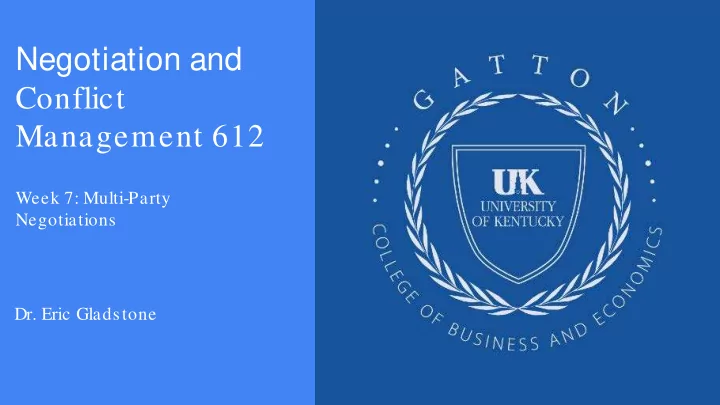

Negotiation and Conflict Management 612 Week 7: Multi-Party Negotiations Dr. Eric Gladstone
Do Your Canvas Assignments Do Your Canvas Assignments
Video Analysis Including today’s class, there are 3 remaini ning ng opportuni unities to record your negotiation. More specifically, the week eek b bef efore e Break eak is t the e las ast o opportunity Laptops are generally best due to memory issues
Final Paper Begin thinking about your final paper Conceptual write up of a real world negotiation Due date to be assigned
Today’s Simulation 3 Firms: Representing Stockman, Turbo, United Find new ew p par artner ers, p per er u usual al May caucus in dy dyads ds for or up p to o 5 minutes Must wal alk aw away ay to caucus Prep ~ 20 minutes Return to class by 7:15 Only sign the agreement form if you ar are e included ed in the e ag agreem eemen ent
Multi -Party Negotiations Often or necessarily involve: A group Norms Power Objectives, goals, interests, timelines Coalitions Allocation of Resources
How Do We Allocate Resources In the absence of formal procedures, what logics can be employed? Without foundational logic: No precedents No expectations Vicious Cycle 3 general models Core, Shapley, Raiffa
The Vicious Cycle Defining the logic of the problem using simultaneous equations Determine quota values by solving the following: Stockman = 0, Turbo = 0, United = 0 Stockman + Turbo = 440 Stockman + United = 380 Turbo + United = 300 Results in quota values totalling more than 480
Distribution Logic 1: Core Solution Set(s) of alternatives which are undominated (McKelvey & Ordeshock, 1980) Alternatives exist in the core if no party can/wants to overthrow Remove 80k/3 from unadjusted quotas Stockman = 233 Turbo = 153 United = 93 But this makes no sense...
Distribution Logic 2: Proportional to Quota Remove 80k as a function of unadjusted quota The proportion of the total quota held by each member: (46.4% x 80,000) = 222, 880 for Stockman (32.2% x 80,000) = 154, 240 for Turbo (21.4% x 80,000) = 102, 880 for United Susceptible to gaming
Distribution Logic 3: Shapley Model Consider a group negotiation beginning with one person (Shapley, 1953) J oined by second player, third player, ad infinitum Examine all permutations of players joining one at a time Determines allocation based on agent’s pivotal power Ability to change the coalition from losing to winning Marginal value added to group’s outcome is attributed to x member Shapley value is the total value added/permutations of sequences
Distribution Logic 3: Shapley Model Ummmmmmm… .what?
Distribution Logic 3: Shapley Model
Distribution Logic 3: Shapley Model
Distribution Logic 3: Shapley Model 3 unique properties: No money left on the table Who get’s what depends on the pie they help create If someone doesn’t assist anyone else in creating value, they get none of the pie I know this is a relatively obtuse idea, so I will post a very well-done video explanation of it. It is very important to understand
Distribution Logic 3: Shapley Model Core solution hurts low power/low resource player Shapley model hurts high power/high resource player Middle power/player is just tired of the bickering A middle-ground between Core and Shapley Raiffa’s hybrid model (1982)
Distribution Logic 4: Raiffa’s Hybrid Model Easy: Mean of Shapley and Core models
Power What is power? How is power distinct from status? Generally, power is non-consensual while status is consensual Power defined (Willer, 2009): 1)Differential access to valued resources 2)Inequity of dependence--to the extent that A is more dependent on B than B is on A, B is said to be more powerful than A
Multi -Party Negotiations Informational complexity Alternative to agreement is being excluded Procedural & distribution processes require a logic Who speaks? Majority rule? Consensus? Who get’s what?
A Note on Groups Promote diversity of thought Reduce outlier effects via centering on the mean (wisdom of crowds) J elly bean counting, moral decision making Group think: Irrational decision making as a group due to concerns for harmony, conformity (J anis, 1972) Suppress dissenters, discard criticality, isolation Ash experiments (1951)
A Note on Groups
Recommend
More recommend